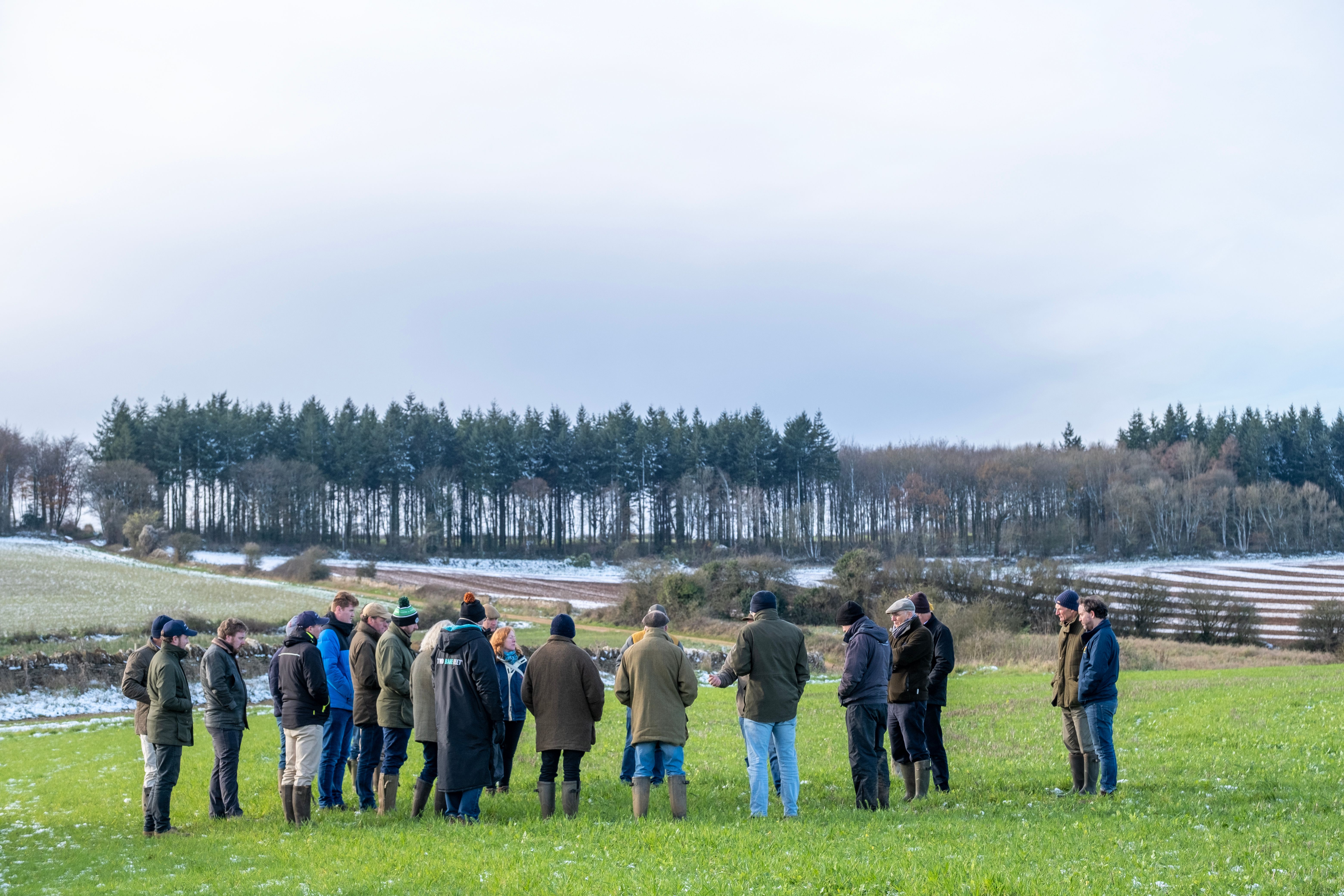
July 2025
Validation of regenerative agriculture practices with Soil Capital
Ensuring the credibility of climate programs is critical to scaling investments in Scope 3 emission reduction. Independent third-party validation provides the trust needed for companies to collaborate effectively across complex agricultural value chains.
In 2025, SustainCERT validated the methodology used by Soil Capital in its “Soil Capital Climate Change Mitigation Program for Arable Farming.” The methodology, “Soil Capital Emission Factor Monitoring Protocol,” is designed to calculate emission factors (EFs) for arable farms in Europe. These EFs represent the greenhouse gas (GHG) intensities of farmers implementing regenerative agriculture practices.
Validation of the program methodology confirms that the approach used to generate emission factors is robust and aligned with international best practice. It also demonstrates the program’s alignment with the GHG Protocol, a globally recognized framework for Scope 3 emissions accounting and reporting. The EFs created by the program can be used by downstream companies for Scope 3 accounting and reporting.
Read on to learn how validation enhances the credibility of Scope 3 programs for regenerative agriculture practices and what that process looked like for Soil Capital.

Caption: Soil Capital’s team on a field visit at one of the participating farms in the UK.
About the Soil Capital Climate Change Mitigation Program
Soil Capital supports the transition of European arable farms to regenerative agriculture practices, improving soil health and farm resilience. The Soil Capital Program enables farmers to measure and monetize their performance, particularly in terms of carbon emissions and soil carbon storing, by connecting them to voluntary carbon markets and agri-food companies. In this way, Soil Capital links the two key sides of the value chain—farmers and food companies—to foster collaboration and build greater resilience across the agricultural system.
The program aims to offer farmers agronomic insights and financial support from the agri-food industry through high-quality data, making the transition to regenerative agriculture practices both scientifically sound and economically viable. The program has been initially implemented in France, Belgium and the UK, with plans to expand it to other EU countries. Soil Capital’s work focuses on regenerative agriculture practices such as reduced land disturbance, cover cropping, maximizing organic inputs, and agroforestry. Participating farmers grow a variety of row crops including wheat, barley, oat, rapeseed, sunflower, potatoes and legumes. To date, 1,800 farms have participated in the program, covering 500,000 hectares, while the program has distributed 10 million euros to farmers with improved GHG outcomes.
The program is anchored in two complementary science-based methodologies developed by Soil Capital and independently validated by SustainCERT. Together, these methodologies enable accurate and granular tracking of on-farm GHG emissions and soil carbon improvements.
- The Value Chain Intervention Design Document uses an intervention-based accounting approach and is intended for conventional farmers joining the program with a net-emitting profile.
- The Emission Factors Monitoring Protocol is specifically designed for early adopter farmers with a net-storing profile and follows an inventory-based accounting approach, in conformity with the draft of the GHG Protocol Land Sector and Removals Guidance (LSRG).
To ensure transparency and ease of implementation, the program includes a full Monitoring, Reporting, and Verification (MRV) system, along with a dedicated farmer-facing digital platform for data collection and engagement. The EFs from the program may be used for reporting aligned with the Corporate Sustainability Reporting Directive (CSRD) and Science-Based Targets initiative (SBTi), where those frameworks accept methodologies based on the GHG Protocol.

Caption: Example of cover cropping at one of the participating farms, displaying a mix of field beans and cereals.
The validation process for regenerative agriculture practices
SustainCERT performed an in-depth, iterative review of all input data, calculation equations, and quality management procedures. This included the evaluation of two distinct protocols, each reflecting one of the main farmer profiles in the Soil Capital Program. While differentiated by farmer type, the methodologies maintain internal consistency and coherence across the program.
- For net-emitting farmers, an intervention approach was validated. Full validation of the methodology, including the baseline, intervention logic, and resulting emission calculations.
- For net-storing farmers, an inventory approach was used. Validation of the Emission Factors only. The method used to assign financial value was outside the scope of validation and remains at Soil Capital’s discretion.
The validation conducted by SustainCERT confirmed that, when properly implemented, the program enables consistent calculation of emission factors across multiple farms and geographies. It is important to note that farm-level data and GHG outcomes derived using the protocol are not part of this validation scope.
Certain methodological aspects, such as emissions from livestock and regionally appropriate agroforestry biomass factors, were flagged for future clarification should the program expand. These Forward Action Requests ensure alignment remains robust under evolving conditions.

Caption: Operating a Slake Test to compare the structure between two types of soil. The regenerative agriculture sample on the right shows better soil structure and is less prone to erosion.
The benefits of validating regenerative agriculture practices
Independent validation of the methodologies under the climate mitigation program allowed Soil Capital to respond to multiple key challenges, including:
1. Program credibility
Validation by SustainCERT allowed Soil Capital to stress-test their methodology against expert scrutiny. Validation strengthens the credibility of the Soil Capital Program by demonstrating conformity with the GHG Protocol and the draft version of the LSRG—the reference standard for the agricultural sector.
Soil Capital identified the lack of clarity surrounding MRV standards and regulations as one of the main barriers to corporate investment in agricultural climate solutions. By aligning with GHG Protocol requirements, corporate partners can have greater confidence in the robustness of the methodology and its outcomes. Access to detailed, credible emission factors is essential for companies to accurately monitor progress over time, attribute emission reductions and removals to specific interventions, and effectively report against Science Based Targets (SBTs).
As the LSRG is still in draft form, careful interpretation of the current draft, close monitoring of updates, and a forward-looking approach that can accommodate future changes were required. Future updates to the LSRG may necessitate revisions to maintain alignment with the final guidance.
2. Recognizing early adopter farmers
Validation is also valuable in the context of an ongoing market debate around how to recognize and reward early adopter farmers. Most prescriptive standards still fall short of offering practical solutions. While the validation focused solely on the technical protocol for calculating EFs, it supports Soil Capital’s efforts to build a credible basis for advocating recognition of early adopters of regenerative agriculture practices. It also addresses the complexity of continuous improvement, integrating soil analysis, different models for carbon measurement and estimation, and working with evolving cohorts of farmers.
3. Focus on Scope 3 solutions
Independent validation reinforces Soil Capital’s positioning on Scope 3 solutions, demonstrating its leadership in sustainable value chain interventions—an increasingly critical area for corporate climate strategies.
Marguerite Delormel, Head of Sales, shares Soil Capital’s approach to value chain interventions:
“When we think about how to turn SBTi’s Net Zero and FLAG standards into action—and with only six harvests left to meet the first FLAG target—waiting isn’t an option. These standards are pushing companies to look upstream, where the bulk of emissions truly lie. But this shift isn’t just about reporting—it’s about business value. It’s about supply security, brand resilience, and maintaining your license to operate. You can’t report your way to resilience—you have to invest in it.”
Unlocking value chain collaboration through credibility
Credibility enables trust — and trust unlocks collaboration. As companies, farmers, and stakeholders are asked to share data, adopt new practices, or co-invest in sustainability initiatives, they need to be confident that the methodologies in use are:
- Scientifically robust
- Transparently applied
- Aligned with shared objectives
Third-party validation against the GHG Protocol—the reference standard for SBTi—helps build trust. It shows that the methodologies of Soil Capital’s Climate Mitigation Program stand up to scrutiny, making it easier for partners to adopt, align with, and invest in.
Ultimately, by lowering perceived risk and increasing confidence, credibility helps translate climate ambition into climate action.
Curious to find out more about value chain validation?
Learn how SustainCERT’s value chain services can help enable trust for regenerative agriculture practices below.

